Story by Colleen O’Neill Nice
I was inspired to write this article after touring gardens in the Pacific Northwest just before travel restrictions were put in place. As I was roaming through “The Farm” of horticulturalist Thomas Hobbs in Langley, British Columbia, I discovered an unusual flower. It was scattered throughout a large, fenced-in area dedicated to vegetables, dahlias and daylilies. The flower form was unique, with hand-painted petals in transitionary shades similar to a watercolor painting. It was love at first sight. The plant was zinnia ‘Zinderella Peach’!
I have always had an affection for zinnias. They are the quintessential summer flowering annual. Their vivid colors glow in my summer garden plus they are heat and drought resistant – not to mention low maintenance. Zinnias are the perfect choice for the novice gardener because they are one of the easiest plants to cultivate. They are adaptable and fast growing, nearly effortless for children to learn to nurture. I grow the large flowering varieties of zinnias to attract honeybees, butterflies and hummingbirds with their nectar. Their long lasting, bright blooms beautify my indoor spaces, where I can appreciate their many shapes and sizes. I use the dazzling-colored petals to brighten salads, summer drinks and desserts. If you love gardening, you will no doubt, love zinnias!

Available in unique color combinations, Zinderella ‘Peach’ is a scabiosa-flowered (pincushion) zinnia. 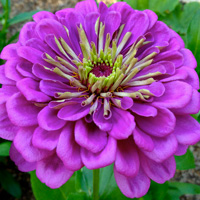
The flowers of the Benary’s Giant Dahlia zinnias grow up to 6 inches across. 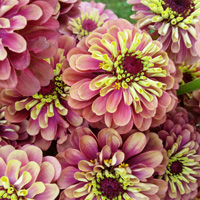
The double flowers of Queen ‘Red Lime’ include shades of rose, pink and soft chartreuse.
Landscape zinnias
Let’s begin with two cultivars of landscape zinnias commonly used in flower borders, beds and containers. Both varieties create an abundance of color and continuously bloom throughout the growing season. The flower structure itself consists of three styles: single-blooms which display a single row of petals with the center of each flower exposed; double-blooms which feature several rows of petals with the center hidden in the petals; and semi-double blooms with an exposed and visible center surrounded by several rows of petals.
The Profusion series, an interspecific hybrid, became an instant hit in the gardening world, and was one of the first zinnias to resist powdery mildew. The plants form compact, vigorous mounds that grow 12 to 18 inches tall and spread to 24 inches wide. The two-inch flowers bloom lavishly over a long season from early summer to frost. They tolerate heat, humidity and drought. Single-bloom colors include red, white, apricot, coral pink, deep apricot, lemon, fire and cherry bicolor. The double-bloom palette features white, cherry, deep salmon, fire and golden yellow. Profusion zinnias love full sun and prefer a well draining, humus-rich, evenly moist soil. Proper plant spacing is critical so avoid overcrowding to prevent poor air circulation. Fortunately, deadheading is not necessary since the new leaves and buds cover the old flowers naturally.
The Zahara series of Zinnia marylandica grow a bit larger than the Profusion series, usually 16 to 20 inches tall. The vibrant blooms are slightly bigger at two-and-a-half inches and continuously blanket the spreading drifts throughout the season. The Zaharas are tough plants and thrive in hot, sunny, dry areas. They are highly resistant to mildew and leaf spot. Single-bloom colors include raspberry, white, pink, yellow, red, and starlight rose (bright rose on white). Double-blooms feature several bi-colors—raspberry ripple (pink with raspberry stripes), sunburst (golden yellow with red stripe) and fire (scarlet-orange) which can be mixed with white, orange, yellow, salmon and cherry. The Zahara zinnias make excellent cut flowers, holding their striking colors as they age.
Profusion and Zahara zinnias are available through local greenhouses and garden centers including Bakers’ Acres in Groton, Kate’s Country Cousins in Lancaster, and Weeks’ Nursery and Greenhouses in Clarence. Green Acre Farm & Nursery in Greece offers a three-color mix of Profusion zinnias in six-inch containers and six packs of Profusion and Zahara zinnias. Palmiter’s Nursery grows both Profusion and Zahara zinnias in jumbo six packs. Seeds are available at Harris Seed, Park Seed, and Swallowtail Garden Seeds.
Scabiosa-flowered zinnias
The Zinderella series of Z. elegans exploded onto the horticulture scene when ‘Zinderella Peach’ won Europe’s Fleuroselect Novelty Award for its unique color and very unusual flower form. It is the first scabiosa-flowered (pincushion) zinnia offered in unique color combinations. Abundant blooms thrive on healthy plants that grow 24 to 36 inches tall. Impressive two-and-a-half-inch crested, delicate flowers are brilliant in bouquets and arrangements.
The frilly double blooms of ‘Zinderella Lilac’ combine soft lavender and blush—with a striking dark center. ‘Zinderella Purple’ has tightly clustered short petals over a skirt of layered, longer, daisy-like petals. It is a very distinct, luscious shade of fuchsia-lilac. ‘Zinderella Peach’ boasts large, crested pompom blooms of bright peach with a delicate cream ring around the central eye. Charming ‘Zinderella Orange’ offers a delicate cream halo and bright tangerine pompoms with hints of deep gold. Creamy white blooms of double, semi-double and single flowers adorn ‘Zinderella White’. For an added punch of color, the fiery-crimson ‘Zinderella Red’ includes both single and large-domed doubles.
Keep your Zinderellas happy and robust by growing them in full sun. Pinch back the seedlings when they are six to eight inches tall to encourage bushiness. Try to thin out plants early, leaving one to one-and-a-half feet between seedlings to discourage disease and increase air circulation. Zinderellas need to be deadhead for continuous blooms. The inflorescence attracts good bugs and pollinators, so scatter your seeds in the vegetable patch and amongst other flowering plants to increase beneficial insects throughout your entire garden. Zinnias are a “cut-and-come-again” annual. They set new buds as soon as the old flowers are cut or deadheaded and then repeat this process reliably all summer. So fill your vases, share bouquets with your neighbors, and float some blooms in your birdbath—the more you cut, the more will bloom. Keep in mind that Zinderella seeds are open-pollinated (they breed true and produce plants identical to their parents), so collect and save some seeds for next year.
If you prefer a medley of vibrant blooms in pink, purple, red, yellow, orange and white with the unique pincushion inflorescence, try a scabiosa-flowered mix. These sun-loving annuals grow to 30 inches tall and thrive in nutrient-rich soil. The textured, two-to-three-inch, dome-shaped blooms resemble the wildflower scabiosa, hence the name. Treat them to bloom-boosting fertilizer during the growing season.
Seed sources include Park Seed, Johnny’s Selected Seed, Swallowtail Seeds, Eden Brothers, and Select Seeds.
Cactus-type zinnias
Some of the loveliest annuals are the cactus-type zinnias (Z. elegans), which have been around for decades. These zinnias have double or semi-double flowers with petals that twist and curl. Spectacular, four-to-five-inch, shaggy blooms include every color of the rainbow except blue. Branching plants grow three feet tall and two feet wide. Their long, strong stems make them ideal for cutting.
Z. elegans ‘Redman Super Cactus’ produces fiery orange-red, six-inch flowers with contrasting yellow flares at the center of each flower. They bloom constantly from June until frost in fertile soil with ample water during dry periods. This new distinct spidery-petaled zinnia is heat tolerant and mildew resistant.
Other cactus-type zinnias are available in color blends such as the giant cactus mixes that include warm shades of yellow, orange, rose, red, pink, salmon, and white. The long, needle-thin petals add texture and long-lasting color to any sunny spots in your garden. Plants grow to 30 inches tall and 12 inches wide with blooms stretching to five inches across. To prevent mildew, water early in the day so foliage can dry off before nightfall or with a soaker hose to minimize wetting the foliage. Space plants generously to prevent overcrowding.
At Renee’s Garden, the custom heirloom mix ‘Raggedy Anne’ includes radiant shades of canary and golden yellow, orange, crimson, scarlet, coral, carmine rose, lilac rose, pink, and white—a shade for every garden color scheme. The giant flower faces have curved and twisted narrow petals like quilled chrysanthemums. Plants can be encouraged to branch if the long stems are cut well back into the plant. Grow large and abundant flowers by thinning the seedlings before they get crowded and watering regularly during dry spells.
Plants are online at Annie’s Annuals and Perennials and White Flower Farm. Purchase seeds at Renee’s Garden, Pinetree Garden Seeds, and Park Seed.
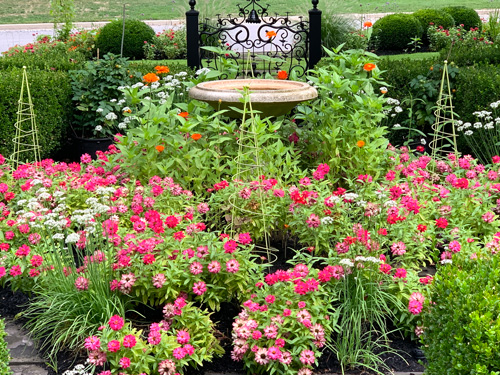
Cut flower zinnias
New to the cut flower category are the unique colorations of the Queen series. Though it is cultivated in the same manner as other zinnias, it is specifically grown in cut flower gardens. Reaching heights of over 4 feet tall at maturity, these stunning plants make a huge visual impact in the landscape and attract multitudes of pollinators as well. They continue to bloom throughout the summer, even as the flowers are cut for use in vases.
The green ‘Queen Lime’ zinnia is popular and stunning with beautiful, double blooms in shades of chartreuse. ‘Queen Red Lime’ offers the same double flowers but transitions from lime green to shades of rose and pink with soft chartreuse in between. ‘Queen Lime-Orange’ displays a cherry center surrounded by lime petals transitionary to orange—simply stunning! The very elegant ‘Queen Lime-Blush’ features splashes of a rosy tint on lime green inflorescences. Flowers are about two to three inches wide and look almost papery and somewhat Victorian. Well-branched plants grow 32 to 40 inches tall and 18 inches wide with sturdy stems. Queen Lime zinnias thrive in summer heat. They bloom from mid to late summer—even into the fall—after many other flowers are exhausted. Be sure to harvest flowers early in the morning when they are fully open, since they will not continue to open once they are cut. To keep flowers fresh in a vase, add a few drops of bleach to the water. Queen series zinnias are lovely in massed plantings and make dramatic additions to containers and garden beds. The ‘Queen Lime’ cultivars can easily be grown from seed if you cannot find transplants at your local garden center or nursery. Refer to the seed starting tips included with my article.
Zinnia ‘State Fair’ mix displays colossal five-inch flowers with flat petals forming single and semi double blooms. A wide range of colors include red, yellow, orange, purple, pink, white and bicolors. Robust plants grow 3 feet tall, exhibit good disease resistance and thrive in sunny, warm conditions. Reenie Sandsted of Bakers’ Acres in Groton sells ‘State Fair Giant’. According to her, “it grows tall, makes a great cut flower, and is our best seller.”
‘State Fair’ mix is available at Green Acre Farm & Nursery in Greece, Kate’s Country Cousins in Lancaster, Palmiter’s Nursery in Avon, and Weeks’ Nursery and Greenhouses in Clarence.
Bakers’ Acres in Groton sells both the ‘Queen’ series and ‘State Fair Giant’ in six packs.
Seeds are available at Hazzard’s Plants & Seeds and Burpee.
Bicolor and multicolor zinnias
The next category of easy-to-grow zinnias are the chic bicolors and swanky multi-colors. Z. elegans ‘Zowie Yellow Flame’ is a showstopper with three-inch, semidouble flowers with iridescent magenta centers and petals dipped in orange. The flowers darken as they age to a ruby-rose, ending with a finale of yellow and red blooms. As the flower matures, a circle of small golden stars surrounds its center disk. An All-American Selections winner, this bicolor grows 24 to 36 inches tall and stands up to heat and tough conditions. Deadheading will keep these annuals producing flowers, while minimal pinching is necessary to keep the plants full.
Zinnia ‘Candy Cane’ mix, an heirloom with double blooms, is bold and vibrantly striped or flecked. Eye-catching, four-inch inch flowers combine bright pink, rose and cherry stripes on white, and sometimes gold, blossoms sprinkled with orange-magenta splotches. Flowers grow 18 inches tall and bloom from midsummer to frost, attracting butterflies and hummingbirds galore.
The beautiful ‘Peppermint Stick’ zinnias include double flowers striped and splotched in shades of cream, yellow, carmine, rosy-purple, orange and scarlet. No two flowers look exactly alike, and they are perfect for arrangements. Heavy bloomers, the 24 to 28 inches tall plants are easy to grow in full sun and are resistant to deer and rabbits.
The bicolor, scarlet-red ‘Mazurkia’ zinnias flaunt petal tips frosted with pearly white. Sturdy, branching plants grow 24 to 30 inches tall and are perfect for containers or sunny borders. Mix ‘Mazurkia’ with annuals like Verbena bonariensis and Cosmos bipinnatus ‘Purity’. Try Salvia guaranitica ‘Black and Blue’ and Nigella damascena ‘Miss Jekyll White’ for lively combinations. The typical vase life for zinnias is seven days, which can be extended further with the use of flower preservatives.
The ‘Whirligig’ mix reminds me of a gallardia or gazania. The cheerful, single to semi-double daisy shaped blooms open in every color and pattern, with lively, multicolor combinations and contrasting petal tips. Reminiscent of pinwheels, the three-to-four-inch flowers grow on 24-inch sturdy stems, perfect for summer bouquets. Prevent mildew by watering early in the day so foliage can dry off and space generously to prevent overcrowding.
Bakers’ Acres in Groton sells ‘Peppermint Stick’. Seeds sources include Harris Seed, Johnny’s Selected Seeds, Burpee, and Thompson & Morgan.
SEED STARTING TIPS:
If you start your zinnia seeds outdoors, choose a spot in full sun, add compost or fertilizer to the soil, and sow seeds at a depth of one-quarter inch. Zinnia seeds germinate well if both air and soil temperatures are more than 70 degrees. Keep soil surface moist until plants emerge. Zinnia seedlings grow in about seven to ten days after sowing. When the seedlings are three inches tall, they need to be thinned out from six to 18 inches apart depending on the variety. This is done to maximize air circulation.
If you start your zinnia seeds indoors, sow seeds five to seven weeks before your last frost date at a depth of a quarter inch in a good seed starting medium in cell packs or flats. Press seeds into the soil and lightly cover. Maintain a temperature of 70-75 degrees F and keep the soil moist. Plants need to be “hardened off” before planting in your garden. This process toughens the plant’s cell structure and reduces transplant shock and scalding from the sun. Acclimatize young plants to outdoor conditions by moving them to a sheltered place outside for a week, protecting them from wind, direct sun and cold temperatures. Once hardened off, choose a location in full sun, add compost or fertilizer to the soil, and space the transplants nine to 12 inches apart, depending on the variety. For strong growth, prolific blooms, and minimal disease and pest damage, water as needed, adding mulch to prevent weeds and retain moisture within the soil.

The shaggy blooms of the heirloom cactus-type zinnias feature narrow, quilled petals. 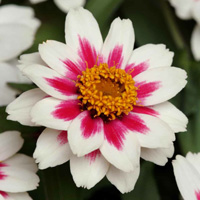
The stunning bi-color bloom of Zahara ‘Starlight Rose’. 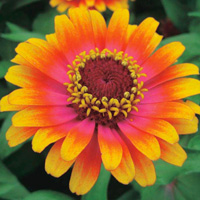
Zinnia ‘Zowie Yellow Flame’ is vibrant with magenta, orange and yellow petals.
Dwarf zinnias
The cutie pies of the zinnia world are the dwarf zinnias—growing from 6 to 14 inches tall and commonly planted in flower borders. Cherished for their small size, these petite plants grow well when interplanted with other annuals, perennials, and shrubs. Although the plants remain small throughout the growing season, the potential bloom size will vary depending upon the zinnia variety.
Zinnia elegans ‘Thumbelina’ mix includes single and semi-double one-and-a-quarter-inch blooms on six-inch plants. The compact, dome-shaped annuals start to bloom at just three inches tall in shades of orange, pink, white, and yellow.
Considered the best dwarf zinnia ever grown, the ‘Magellan’ series is truly an outstanding garden performer, especially as a bedding plant. The vibrant, double, four-to-five-inch flowers are arranged with layer after layer of petals crowned with a frilly yellow center. The sturdy, 14-inch plants are smothered with blooms over a long summer season. The mix contains seven bold colors including cherry, pink, orange, ivory, yellow, scarlet, and coral. Seeds for each of the colors can be purchased separately as well. Deadhead the old flowers to keep new buds developing for even more superb color!
The ‘Dreamland’ series has been around for several years enticing gardeners with its early, four-inch, long-lasting blooms on compact, robust 10 to 12-inch plants. The dahlia-form flowers, with waxy petals, are rugged and weather-tolerant during summer storms. They quickly form a solid carpet of color in large beds and borders. Eight harmonious hues include apricot, coral, pink, rose, yellow, ivory, red, and scarlet! Marla Palmiter at Palmiter’s Nursery in Avon offers the ‘Dreamland’ series and grows both a mix and the coral. According to Palmiter, “The ‘Dreamland’ coral is gorgeous and very popular.” When cut, the flowers are stunning and stay fresh for well over a week in a vase. If growing ‘Dreamland’ from seed, sow in succession for a longer flowering period.
Tom Pfentner, owner of Weeks’ Nursery and Greenhouses in Clarence, has been growing zinnias for more than 50 years. “We started with the ‘Dreamland’ varieties then added the ‘Profusion’ and ‘Zahara’s. We also grow the tall ‘State Fair’ mix,” he says. “Zinnias are prolific bloomers and continue flowering well into the fall.”
‘Dreamland’ plants are available at Palmiter’s and Weeks’ Nursery and Greenhouses in Clarence. Kate’s Country Cousins in Lancaster sells the ‘Magellan’ series in four-and-a-half inch pots. Green Acre Farm & Nursery in Greece grows the ‘Dreamland’ and ‘Thumbelina’ mixes in six packs and ‘Magellan’ mix in eight-inch containers. Seed sources include Burpee and Park Seed.

Dahlia-flowered zinnias
Benary’s ‘Giant Dahlia’ series (Z. elegans) is considered a premium zinnia recommended by the Association of Specialty Cut Flower Growers. Densely petaled blooms create a beehive shape with added dimension, growing up to six inches across. They are long-lasting in bouquets. Colors include deep red, orange, carmine rose, coral, lime, wine, purple, bright pink, white, salmon rose, scarlet, and golden yellow. Seeds can be purchased by color or in a mix. Benary’s giants are vigorous, reaching heights of 40 to 50 inches and holding up remarkably well in summer rain and heat.
The Z. elegans ‘Giant Dahlia Flowered’ mix offers a vibrant combination of yellows, roses, scarlet, green, orange, pink, red, purple, and coral flowers on strong, 30-to-40-inch stems. Similar in color and habit to Benary’s giants, the flower structure of the ‘Giant Dahlia’ mix includes single, double and semi-double, 4-to-6-inch blooms. Collect and save the seed for next year, since both varieties are open-pollinated.
Seeds are available at Harris Seed, Swallowtail Seeds, Johnny’s Selected Seeds, and Hazzard’s Plants & Seeds.
Zinnias are the hardest working flower that you can employ in your summer garden! They are fast growers. Plan to direct-sow zinnia seeds in the spring, then sow a second batch in mid-summer. Fill your containers with zinnias using quick and easy six packs. All zinnia varieties—old or new—can brighten up your garden when it may be looking a little tired by summer’s end. Zinnias make colorful companions for ornamental grasses, roses, sunflowers, black-eyed Susans and hydrangeas. Scatter zinnia seeds in your perennial garden to add color and fill in spaces as you wait for plants to mature. When native plant sources are running low on pollen and nectar, attract hummingbirds, bees and butterflies with large-flowered varieties. Plant bright and beautiful zinnias in a butterfly garden near your porch or patio so you can enjoy them as well. The only challenging aspect of growing zinnias is deciding which varieties to plant.
ONLINE PLANT & SEED SOURCES:
Annie’s Annuals and Perennials
www.anniesannuals.com
Burpee
www.burpee.com
Eden Brothers
www.edenbrothers.com
Harris Seed
www.harrisseeds.com
Hazzard’s Plants & Seeds
www.hazzardsgreenhouse.com
Johnny’s Selected Seed
www.johnnyseeds.com
Park Seed
www.parkseed.com
Pinetree Garden Seeds
www.superseeds.com
Renee’s Garden
www.reneesgarden.com
Select Seeds
www.selectseeds.com
Swallowtail Garden Seeds
www.swallowtailgardenseeds.com
Thompson & Morgan
www.thompson-morgan.com
White Flower Farm
www.whiteflowerfarm.com
Colleen O’Neill Nice is an avid gardener in Clarence.
Views: 0




